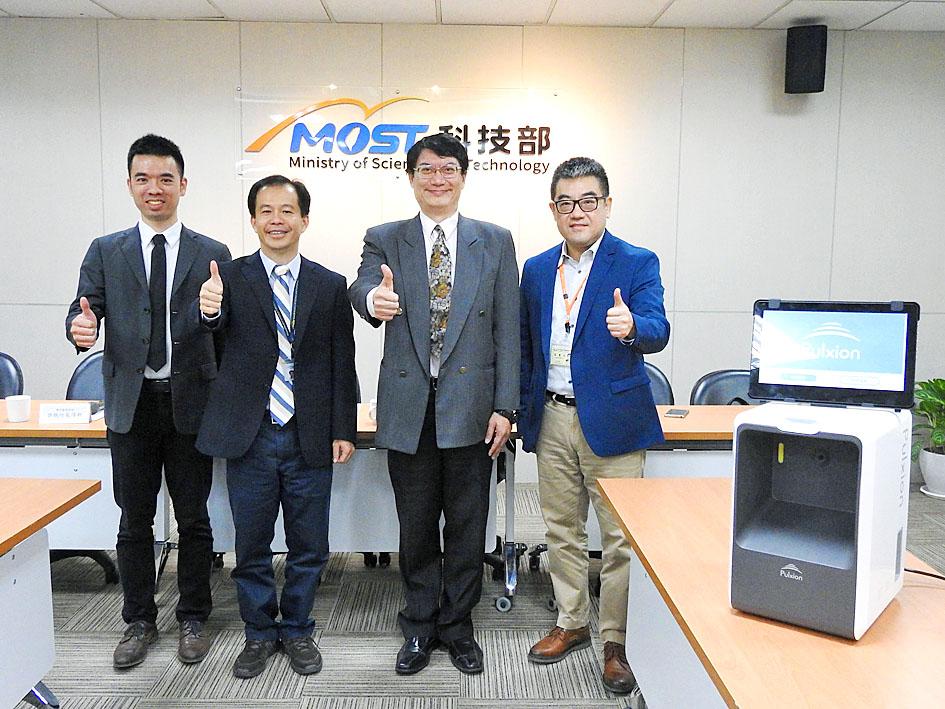A research and start-up team yesterday introduced the world’s first quick-test imaging system for stroke and cardiovascular diseases that can deliver results in five minutes.
Stroke ranks among the five top causes of death in Taiwan and the US, claiming about 12,000 and 140,000 lives each year respectively, National Taiwan University (NTU) mechanical engineering professor Hsiao Hao-ming (蕭浩明) told a news conference at the Ministry of Science and Technology in Taipei.
Hsiao said that he had worked at US Abbott Laboratories, developing medical devices from 2001 to 2009, before returning to Taiwan.

Photo courtesy of the Ministry of Science and Technology via CNA
About 85 percent of strokes are caused by ischemia, or a blockage in an artery that supplies blood to the brain, while carotid artery stenosis — a narrowing of the two major carotid arteries that carry blood from the heart to the brain — is an early indicator of stroke, he said.
Many people with cardiovascular diseases might suffer a stroke without foreseeable symptoms, so early detection is key to prevention, National Taiwan University Hospital (NTUH) cardiologist Kao Hsien-li (高憲立) said.
However, existing diagnostic tools, such as ultrasonic scanning, magnetic resonance angiography and computed tomography, are bulky, costly and need a professional operator, Hsiao said.
To facilitate early detection of strokes and cardiovascular diseases, they worked together to develop an imaging device called Pulstroke.
The device takes a 30-second video of a subject’s neck and uploads the film to a cloud server for analysis, Hsiao said.
Within five minutes, the subject can receive an assessment report on their risks of getting carotid artery stenosis and determine if they should visit a hospital for a more detailed examination, he said.
The degree of stenosis affects the dynamics of blood flow, the subtle changes of which are reflected through pulsations and can be detected by the team’s image motion analysis, he added.
The system has accumulated more than 500 clinical cases, with a precision rating of 95 percent compared with results yielded by ultrasonic scanners, he said.
The team has obtained patents for the system in Taiwan and the US, and won two National Innovation Awards in Taiwan in 2016 and last year, Hsiao said.
The system’s hardware was refined when the team received more funding from the ministry last year, he added.
While the device only needs ordinary Webcams for taking images, the team’s core technology hinges on image motion analysis, image decomposition and reconstruction, feature extraction and an artificial intelligence algorithm, he said.
In June, the team established a start-up company, Pulxion Medical Technology, with Hsiao serving as chief technology officer and Kao as chief medical officer.
The firm is awating a medical device permit from the Ministry of Health and Welfare to make it commercially available, Hsiao said.
Instead of selling the system itself, the firm plans to promote its use at pharmacies and health checkup centers, with users being charged NT$200 to NT$300 per use, only about 10 percent of the cost of self-paid checks for carotid artery stenosis at hospitals, company CEO Thomas Hsu (許沛新) said.
The company would also seek cooperation with the health ministry to promote use of the system and integrate users’ data into the database of National Health Insurance Administration, Hsiao said.
The technology could also be used to develop other tools for detecting arrhythmia, arteriovenous fistula occlusion and Parkinson’s disease, he said.

WANG RELEASED: A police investigation showed that an organized crime group allegedly taught their clients how to pretend to be sick during medical exams Actor Darren Wang (王大陸) and 11 others were released on bail yesterday, after being questioned for allegedly dodging compulsory military service or forging documents to help others avoid serving. Wang, 33, was catapulted into stardom for his role in the coming-of-age film Our Times (我的少女時代). Lately, he has been focusing on developing his entertainment career in China. The New Taipei District Prosecutors’ Office last month began investigating an organized crime group that is allegedly helping men dodge compulsory military service using falsified documents. Police in New Taipei City Yonghe Precinct at the end of last month arrested the main suspect,

A cat named Mikan (蜜柑) has brought in revenue of more than NT$10 million (US$305,390) for the Kaohsiung MRT last year. Mikan, born on April 4, 2020, was a stray cat before being adopted by personnel of Kaohsiung MRT’s Ciaotou Sugar Refinery Station. Mikan was named after a Japanese term for mandarin orange due to his color and because he looks like an orange when curled up. He was named “station master” of Ciaotou Sugar Refinery Station in September 2020, and has since become famous. With Kaohsiung MRT’s branding, along with the release of a set of cultural and creative products, station master Mikan

RISING TOURISM: A survey showed that tourist visits increased by 35 percent last year, while newly created attractions contributed almost half of the growth Changhua County’s Lukang Old Street (鹿港老街) and its surrounding historical area clinched first place among Taiwan’s most successful tourist attractions last year, while no location in eastern Taiwan achieved a spot in the top 20 list, the Tourism Administration said. The listing was created by the Tourism Administration’s Forward-looking Tourism Policy Research office. Last year, the Lukang Old Street and its surrounding area had 17.3 million visitors, more than the 16 million visitors for the Wenhua Road Night Market (文化路夜市) in Chiayi City and 14.5 million visitors at Tainan’s Anping (安平) historical area, it said. The Taipei 101 skyscraper and its environs —

Taiwan on Friday said a New Zealand hamburger restaurant has apologized for a racist remark to a Taiwanese customer after reports that it had first apologized to China sparked outrage in Taiwan. An image posted on Threads by a Taiwanese who ate at Fergburger in Queenstown showed that their receipt dated Sunday last week included the words “Ching Chang,” a racial slur. The Chinese Consulate-General in Christchurch in a statement on Thursday said it had received and accepted an apology from the restaurant over the incident. The comment triggered an online furor among Taiwanese who saw it as an insult to the